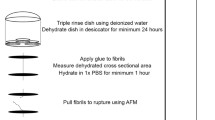Abstract
The mechanical properties of collagenous tissues, such as tendon and ligaments, are of particular interest as they are found extensively in the human body. In the present study the transverse mechanical properties of collagen fibers are reported for the first time. The elastic modulus was found to be 63 ± 4 MPa, while the viscosity was estimated to be \( 14\;{\text{GPa}} \le \eta \le 56\;{\text{GPa}}\;{\text{s}} \). Comparison with similar data in the literature, for bulk tendon and collagen fibrils, suggests that the apparent modulus of a network of interconnected building blocks is reduced as compared to the modulus of the individual building blocks; in particular E tendon < E fiber < E fibril; this is due to the fact that as the scale of the microstructure increases (i) slippage and sliding between the respective building blocks (fibrils or fibers) increases, (ii) the volume fraction of the stiff collagen proteins decreases.







Similar content being viewed by others
References
Moore SM, McMahon PJ, Debski PE. Bi-directional mechanical properties of the axillary pouch of the glenohumeral capsule: implications for modeling and surgical repair. J Biomech Eng Trans ASME. 2004;126(2):284–8.
Moore SM, McMahon P, Azemi E, Debski R. Bi-directional mechanical properties of the posterior region of the glenohumeral capsule. J Biomech. 2005;38(6):1365–9.
Quapp KM, Weiss JA. Material characterization of human medial collateral ligament. J Biomech Eng Trans ASME. 1998;120(6):757–63.
Stabile KJ, Pfaeffle J, Weiss JA, Fischer K, Tomaino MM. Bi-directional mechanical properties of the human forearm interosseous ligament. J Orthop Res. 2004;22(3):607–12.
Yamamoto E, Hayashi K, Yamamoto N. Effects of stress shielding on the transverse mechanical properties of rabbit patellar tendons. J Biomech Eng Trans ASME. 2000;122(6):608–14.
Lynch HA. Effect of fiber orientation and strain rate on the nonlinear uniaxial tensile material properties of tendon. J Biomech Eng Trans ASME. 2003;125(5):726–31.
Chung K-H, Bhadriraju K, Spurlin TA, Cook RF, Plant AL. Nanomechanical properties of thin films of type I collagen fibrils. Langmuir. 2010;26(5):3629–36.
Wenger MPE, Bozec L, Horton MA, Mesquida P. Mechanical properties of collagen fibrils. Biophys J. 2007;93:1255–63.
An K-N, Sun Y-L, Luo Z-P. Flexibility of type I collagen and mechanical property of connective tissue. Biorheology. 2004;41:239–46.
Oliver WC, Pharr GM. An improved technique for determining hardness and elastic-modulus using load and displacement sensing indentation experiments. J Mater Res. 1992;7(6):1564–83.
Odegard GM, Gates TS, Herring HM. Characterization of viscoelastic properties of polymeric materials through nanoindentation. Exper Mech. 2005;45(2):130–6.
Oyen ML. Sensitivity of polymer nanoindentation creep measurements to experimental variables. Acta Mater. 2007;55(11):3633–9.
Hauch KN, Oyen ML, Odegard GM, Haut-Donahue HL. Nanoindentation of the insertional zones of human meniscal attachments into underlying bone. J Mech Behav Biomed Mater. 2009;2(4):339–47.
Ebenstein DM, Pruitt LA. Nanoindentation of soft hydrated materials for application to vascular tissues. J Biomed Mater Res Part A. 2004;69A:222–32.
Chaudhry B, Ashton H, Muhamed A, Yost M, Bull S, Frankel D. Nanoscale viscoelastic properties of an aligned collagen scaffold. J Mater Sci: Mater Med. 2009;20:257–63.
Feng G, Ngan AHW. Effects of creep and thermal drift on modulus measurement using depth-sensing indentation. J Mater Res. 2002;17(3):660–8.
Tang B, Ngan AHW. Accurate measurement of tip—sample contact size during nanoindentation of viscoelastic materials. J Mater Res. 2003;18:1141–8.
Dowling NE. Mechanical behavior of materials: engineering methods for deformation, fracture, and fatigue. 3rd ed. Upper Saddle River, NJ: Pearson Prentice Hall; 2007.
Shakai M, Simizu S. Indentation rheometry for glass-forming metals. J Non-Cryst Solids. 2001;282:236–47.
Gupta S, Carrillo F, Li C, Pruitt L, Puttlitz C. Adhesive forces significantly affect elastic modulus determination of soft polymeric materials in nanoindentation. Mater Lett. 2007;61:448–51.
Pioletti DP, Rakotomanana LR, Benvenuti J-F, Leyvraz P-F. Viscoelastic constitutive law in large deformations: application to human knee ligaments and tendons. J Biomech. 1998;31:753–7.
Acknowledgments
KEA and SS are grateful for support from KEA’s European Research Council Starting Grant, MINATRAN-211166. The authors are also thankful to Ms. Betty for her assistance in the experiments.
Author information
Authors and Affiliations
Corresponding author
Rights and permissions
About this article
Cite this article
Aifantis, K.E., Shrivastava, S. & Odegard, G.M. Transverse mechanical properties of collagen fibers from nanoindentation. J Mater Sci: Mater Med 22, 1375–1381 (2011). https://doi.org/10.1007/s10856-011-4320-9
Received:
Accepted:
Published:
Issue Date:
DOI: https://doi.org/10.1007/s10856-011-4320-9




